
All categories
Featured selections
Trade Assurance
Buyer Central
Help Center
Get the app
Become a supplier

(1471 products available)

































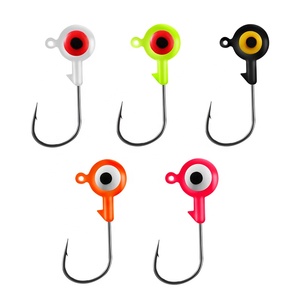
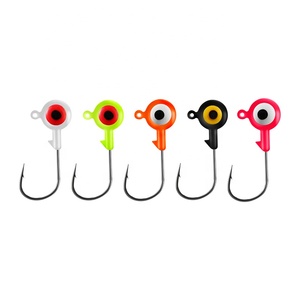
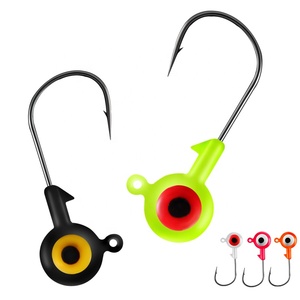
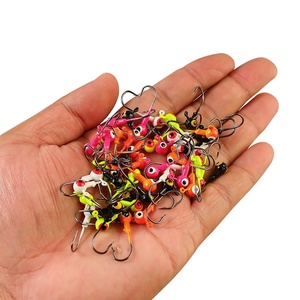
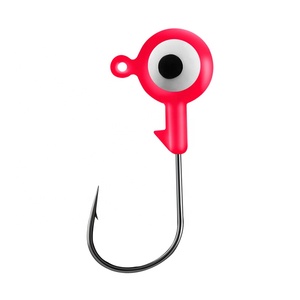
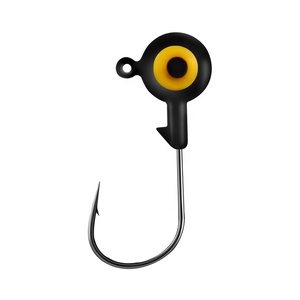






Crappie tackle is used for catching crappies, which are freshwater fish species. They are rather small fish; hence, their tackle is light and small. There are different types of crappie tackles, and each one is designed to help catch a crappie.
Crappie Rods
Crappie rods are long and flexible, ranging from 5 to 8 feet in length. They are designed to cast small lures or baits far and have a sensitive tip to feel the lightest bites. They are made from graphite or fiberglass, which is lightweight and strong, with a comfortable handle for long fishing days. They have a fast action that bends in the lower part of the rod to the middle part, and a medium power that is able to lift a few ounces. This action and power is perfect for casting small lures or live baits and feeling the crappie's subtle bite.
Crappie Reels
Crappie reels are small and lightweight, designed to hold 4 to 10-pound test line. They have a smooth drag system that helps fight the fish without breaking the line. They are easy to use with one hand, have a good gear ratio for quick line retrieval, and a sturdy handle for winding in the line. They are made from durable materials like aluminum or graphite and can withstand the harsh conditions of freshwater fishing.
Crappie Fishing Line
Crappie fishing line is thin and strong, with low visibility in the water. It comes in mono, braid, and fluoro types. The line is easy to handle and tie knots with, and it stretches slightly to absorb shocks without breaking. Each type has its benefits; for instance, the monofilament is great for beginners, braid has little stretch, and fluoro has low visibility, which is great for clear water. The line is spooled on the reel in a way that prevents twists and kinks for smooth casting and retrieval.
Crappie Jigs
Crappie jigs come in various colors and weights. They have a lead head and hook with a soft body that mimics small fish or insects. The jigs are rigged by tying the line to the jig's eye, and they are cast or dropped to the desired depth. Once the jig hits the water, it is retrieved by winding the line or with small hops to imitate the movement of live bait. Crappie jigs are effective year-round, especially in spring and fall when the fish are shallow.
Crappie Lures
Crappie lures are small, shiny, and colorful, imitating injured bait fish. They are cast or trolled at various speeds to find the right action that attracts crappies. They are best used during the day when crappies are active and feeding on small fish. Crappie lures are effective in both clear and stained water and can be used in shallow and deep water. They are reeled in steady or with pauses to mimic the natural movement of bait fish.
Crappie Live Bait
Crappie live bait includes minnows, worms, and insects. It is hooked through the lips, tail, or body and then cast or dropped to the desired depth. Live bait is most effective in stained water or when fish are not biting lures. It is also a great way to fish for crappies at night when they are feeding on insects and small fish. Live bait is more forgiving for beginners as it does not require precise casting or retrieval.
Crappie Tackle Box
A crappie tackle box is a portable storage container with compartments to organize lures, lines, hooks, and tools. It is made from durable plastic or metal with a handle for easy transport. Some tackle boxes have trays that stack on top of each other and others with wheels for easy movement on the ground. Crappie tackle boxes come in various sizes to fit different needs, from small boxes for a few essentials to large boxes that hold everything one needs for crappie fishing. They keep everything organized and accessible on the water, making it easy to find and use the right tackle for each situation.
Crappie fishing tackle is designed with a primary focus on versatility and delicacy. Here are some key components and their design features:
Rod
The rod is designed for sensitivity and sturdiness. It's thin and light with a fast action tip. The fast action helps the rod bend quickly near the tip end. This design enables the rod to respond fast and bend in a split second when a fish bites. The tip is sensitive enough to feel the lightest bite of a crappie. The balance between the sensitivity and strength lets the angler feel the fish and set the hook before the fish feels the hook.
Reel
The reel is small and light with a smooth drag. It holds light line well. The line capacity is enough for 100 yards of 4 to 6-pound test line. The drag system works well with light lines. The gears are designed for smooth and quiet operation. The retrieve ratio is between 5:1 and 6:1. The handle is easy to grip and turn. It has a one-way clutch bearing for instant anti-reverse. The reel's design helps cast light baits far without backlashing the spool. It aids in fighting small fish without the drag locking up.
Line
Crappie line is thin and clear to avoid spooking fish. It's strong for its diameter and has low memory. The line sinks well and follows the bait to the depth. The line's design helps feel the bottom and detect bites. It handles knots well and retains its strength after tying. The line is suitable for casting and trolling. It works well with light jigs and minnows, aiding in presenting baits naturally. The line's invisibility under water increases the chances of a crappie's bite. Strong yet thin, it helps land more fish.
Bait and Lures
Crappie bait comes in various jigs, lures, and live bait. Jigs are small and light, often with bright colors like chartreuse or white. They have soft plastic tails that flutter and mimic a struggling minnow or insect. The design attracts crappies with its movement and color in stained waters. Crappie lures vary from spinners to crankbaits. Spinners have blades that spin and create flashes, while crankbaits dive and wobble. Both are designed to cover more water and locate active crappies. Live baits like minnows and worms are effective and natural. They are fished on small hooks with split shots or floats. The design focuses on the natural movement of the bait to entice crappie.
Accessories
Crappie fishing tackle includes various accessories. It has small, bright colored bobbers that float and indicate bites by submerging. Split shots are light sinkers that help the bait sink or balance the rig. Tiny swivels prevent line twists and retain the line's strength. Tackle boxes are organized with trays for easy access. Each accessory has a specific role in enhancing the crappie fishing experience. Together, they help set up and adjust the rig for effective fishing.
Crappie fishing requires the right combinations of tackle and techniques to be successful in catching this fish. Here are suggestions on how to wear or match the various crappie tackle components effectively.
Matching the Rod and Reel
The crappie fishing rod should be light and sensitive to detect crappies striking the bait. The reel should be smooth and have a good drag system to handle the fight of the crappie. A spinning reel is the best choice for crappie fishing because it can handle light line well. The line should be matched to the rod and reel's capacity. A 4 to 6 lb test line is ideal for crappie fishing.
Combining Lures and Techniques
Crappie lures should be combined with the right techniques to catch crappie. Jigs should be used vertically, dropped to the bottom, and slowly retrieved. Spinners should be cast and retrieved, covering water to find crappies. Crankbaits should be trolled or cast and retrieved, mimicking the baitfish. Soft plastics should be fished on a jig head or drop shot, mimicking the worms and insects.
Pairing Live Bait with Presentation Techniques
Live bait should be paired with presentation techniques that mimic natural movement. Minows should be hooked through the lips or tail and fished under a bobber or on a jig head. Worms should be fished on a drop shot or jig head, while insects should be fished on a small hook with no weight. The key is to present the live bait in a way that imitates its natural movement.
Integrating Accessories
Accessories are important for crappie fishing. Bobbers help detect bites and keep the bait at the right depth. Weights help sink the line and control the bait's depth. Hooks should be sharp and the right size for the bait and technique. Pliers and scissors are necessary for handling line and hooks. A fish finder or GPS can help locate crappies in the water.
Using Tackle in Different Environments
Crappie tackle should be adapted to different environments. In clear water, use light line and small lures. In stained water, use darker lures and heavier line. In heavy cover, use stronger line and heavier tackle. Open water requires lighter line and tackle. Rivers and lakes require adjusting to the current and depth.
Q1: What is the best tackle for crappie fishing?
A1: The best tackle for crappie fishing includes light to ultra-light spinning rods and reels, 4 to 6-pound test line, and a variety of jigs, minnows, and small lures. This setup allows for precise presentations and better sensitivity to detect bites.
Q2: How does one choose the right crappie fishing tackle?
A2: Choose the right crappie fishing tackle based on the fishing environment and techniques. For jigging, a sensitive rod and small jigs work well. For live bait fishing, a spinning rod with a slip bobber setup is effective. Consider the water clarity and depth when selecting lures and baits.
Q3: What are the essential components of a crappie fishing rig?
A3: The essential components of a crappie fishing rig include the fishing rod, reel, line, terminal tackle (hooks, weights, and bobbers), and lures or bait. Each component plays a crucial role in effectively catching crappie.
Q4: What are the different types of crappie fishing lures and baits?
A4: Different types of crappie fishing lures and baits include jigs, minnows, worms, small crankbaits, and spinnerbaits. Jigs and minnows are particularly effective, but the best choice depends on the fishing conditions and crappie's preferences.
Q5: How important is the fishing line for crappie fishing?
A5: The fishing line is crucial for crappie fishing as it affects sensitivity, casting distance, and overall performance. A 4 to 6-pound test line is ideal for light crappie tackle, providing the strength needed to land fish without spooking them.